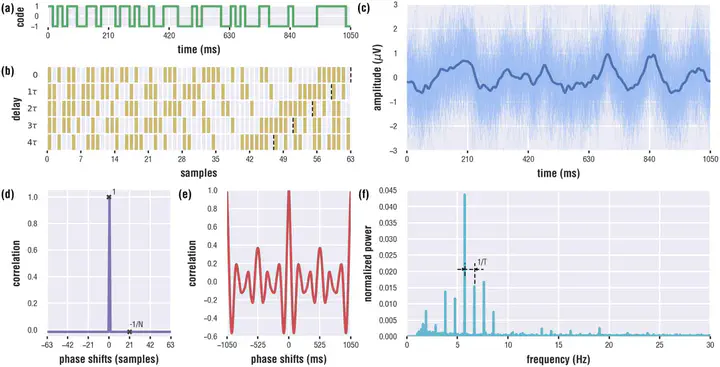Stimulus characteristics of c-VEP BCI

Context
A brain-computer interface (BCI) has the capability to use a diverse array of control signals decoded from measured electroencephalogram (EEG) data. One notably effective control signal for achieving high accuracy and speed in BCI performance, particularly in communication and control applications, is the code-modulated visual evoked potential (c-VEP).
The c-VEP is generated in response to a pseudo-random sequence of flashes. The sequences are commonly taken from telecommunications as they have ideal low correlation properties. Typically, these sequences are binary and as such represent alternations between black and white images on a screen. Such high-contrast alternations may contribute to a high response amplitude, but also come with challenges such as low user comfort.
Despite the success of c-VEP BCIs in reaching world’s fastest non-implanted BCI for communication and control, large steps can still be made to improve its practicality. Some ideas to further improve the (visual) comfort:
- Faster presentation rate, potentially pushing the stimuli beyond the perceptual threshold making them invisible.
- Reducing contrast, potentially to such an extend that the flashes become imperceptible.
- Using textured images rather than full black/white stimuli, which may increase signal-to-noise and potentially add additional relevant ERP components.
- Using non-binary stimulus sequences, such as simply (band limited) white noise.
Image credit: Martínez-Cagigal, V., Thielen, J., Santamaría-Vázquez, E., Pérez-Velasco, S., Desain, P., & Hornero, R. (2021). Brain–computer interfaces based on code-modulated visual evoked potentials (c-VEP): A literature review. Journal of Neural Engineering.
Research question
This project is dedicated to investigating how modifying specific properties of stimulation influences c-VEP BCI performance and user comfort. As part of this project, you will focus on one such property. You will implement and condact an EEG experiment, and analyze the experimental conditions.
On top of evaluating alternative forms of stimulation, doing so also opens up exciting possibilities for advancing machine learning algorithms. Additionally, post-hoc analyses could scrutinize the neural responses associated with improved or diminished BCI performance.
This investigation not only holds the potential to improve BCI performance, but also provides a unique opportunity to gain insights into vision neuroscience. Specifically, it may unveil how the brain responds to visual stimuli, as measured by EEG, facilitating a deeper understanding of the intricate interplay between stimulus characteristics and neural activity.
Literature
An example study investigating binary stimulus sequences:
- Thielen, J. (2025). Addressing BCI inefficiency in c-VEP-based BCIs: A comprehensive study of neurophysiological predictors, binary stimulus sequences, and user comfort. Biomedical Physics & Engineering Express. DOI: https://doi.org/0.1088/2057-1976/ade316
An example study investigating non-binary stimulus sequences:
- Martínez-Cagigal, V., Santamaría-Vázquez, E., Pérez-Velasco, S., Marcos-Martínez, D., Moreno-Calderón, S., & Hornero, R. (2023). Non-binary m-sequences for more comfortable brain–computer interfaces based on c-VEPs. Expert Systems with Applications, 232, 120815. DOI: https://doi.org/10.1016/j.eswa.2023.120815
An example study using narrow-band white noise stimuli:
- Dong, Y., Zheng, L., Pei, W., Gao, X., & Wang, Y. (2025). A 240-target VEP-based BCI system employing narrow-band random sequences. Journal of Neural Engineering, 22(2), 026024. DOI: https://doi.org/10.1088/1741-2552/adbfc1
An example study investigating stimulus appearance (contrast and texture):
- Dehais, F., Castillos, K. C., Ladouce, S., & Clisson, P. (2024). Leveraging textured flickers: a leap toward practical, visually comfortable, and high-performance dry EEG code-VEP BCI. Journal of Neural Engineering, 21(6), 066023. DOI: https://doi.org/10.1088/1741-2552/ad8ef7
Skills / background required
- Knowledge and an interest in brain-computer interfacing
- Knowledge and an interest in vision neuroscience
- Very proficient in Python